Aims to provide an in-depth analysis of Disneyland's marketing strategies and display understanding of marketing terms. By Reina LeBrun.
Don't wanna be here? Send us removal request.
Video
youtube
POST 14: “Presentation”
A narration of the work completed this semester.
0 notes
Text
POST 13: “Promotion”
Disneyland operates on many social media platforms and has pages on Facebook, LinkedIn, Yelp, Pinterest, Twitter, and more.
-Upon analyzing Disneyland’s Facebook page (https://www.facebook.com/Disneyland/), they seemed to be focusing on the next seasonal event happening in the parks. The first few posts contained photos and videos of the holiday elements recently added to the park with the tag “The Holidays Begin Here”. These posts were followed by customer ratings and reviews. Disneyland’s website was also prominently displayed here and their page seems active, with the most recent post from only 2 days ago.
-Disneyland’s LinkedIn page (https://www.linkedin.com/company/disneyland-resort) contained more professional information and did not reference seasonal changes in the parks at all. The page contained a short biography of the company as well as quick facts like the number of employees, industry of the firm, and website. The page seemed active, with posts as recent as two days ago posting a hiring opportunity at the Disneyland Resort. The website seems like a good place to start when searching for employment with this company.
-When examining Disneyland’s Yelp page (https://www.yelp.com/biz/disneyland-park-anaheim-7), the page had been claimed and contained lots of practical information about the park right away, such as their address, phone number, and website. This page was the most focused on informational appeals. Further down the page contained business hours and additional information. There were also many reviews, photos, and questions being answered regarding the park.
-Disneyland’s Pinterest (https://www.pinterest.com/disneyland/) advertised “Disneyland tips, tricks, and a little bit of magic!” and contained a variety of boards for Disney fans to view, from holiday tips to Disney humor and art boards. This platform had noticeably less information and interaction, only listing the URL of their website.
-Disneyland’s Twitter page (https://twitter.com/Disneyland) seemed the most similar to their Facebook page, with recent posts including advertising in the form of video ads about the holidays and the same promotional photos of the park. Their Twitter had over 1 million followers and 20,000 tweets.
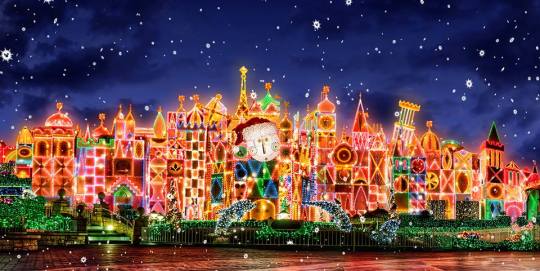
In addition to the video advertisements I encountered when viewing this company’s social media pages, I have recently heard mass media advertisements for Disneyland on the radio and seen billboards for the park. These seemed to be reminder advertising for the most part. It is hard to say how effective advertising around southern California is because of the massive amount of brand awareness we have here for Disneyland. Disneyland has been using holiday events as well as Star Wars in their billboard ads recently, appealing to fans of the films (“Star Wars Awakens Disneyland billboards…”, 2016).
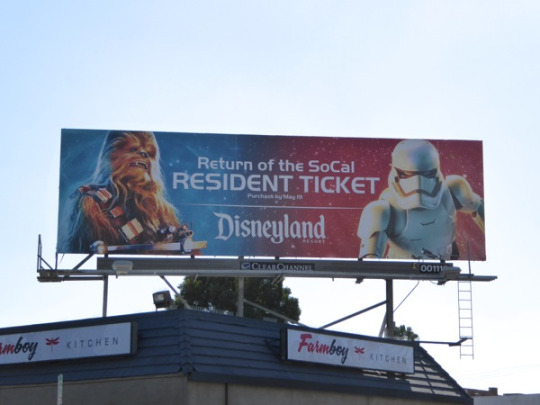
I think it is pretty uncommon for Disneyland to have sales promotions for their tickets, but savings can be found through promotions in retailers where Disney gift cards or tickets are sold, such as Target, and the Disney Store website was offering Black Friday deals for Disney products ("Official Site for Disney Merchandise", 2017). I think some personal selling is used with this company through email. Personal selling can be useful for Disneyland’s wealthier customers for the more premium services Disneyland offers.
J. (2016, March 12). Star Wars Awakens Disneyland billboards... Retrieved November 26, 2017, from http://www.dailybillboardblog.com/2016/03/star-wars-awakens-disneyland-billboards.html
Official Site for Disney Merchandise. (2017). Retrieved November 26, 2017, from https://www.shopdisney.com/
0 notes
Text
POST 12: “Place (Distribution)”
Disneyland’s distribution intensity for tickets I think is selective distribution. Disneyland sells tickets through their own website and at the gates of the park, but they also allow some retailers to sell tickets. By partnering with conventional supermarkets like Stater Bros. (Disney, 2016), Disneyland is maintaining their image as a family vacation destination and positioning themselves conveniently for families grocery shopping. Disney does not use an intensive distribution strategy because it is also important to them to control how many tickets are being sold, and they have more than enough demand to be selective about their retail partnerships (when considering park tickets). Disneyland is primarily a service retailer, but also sells official Disney merchandise at specialty stores throughout the property like World of Disney (Disney, 2017).
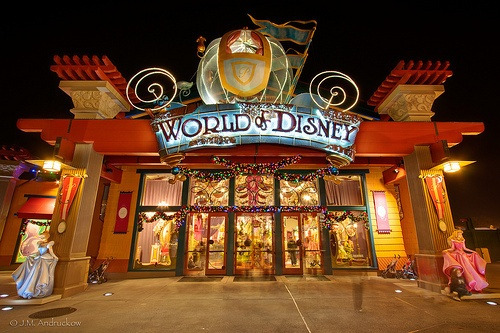
Benefits of Buying at the Grocery Store. (2016). Retrieved November 26, 2017, from http://grocerystoredisneylandtickets.com/
Shops | Disneyland . (2017). Retrieved November 26, 2017, from https://disneyland.disney.go.com/shops/
0 notes
Text
POST 11: “Trends/Pricing”
According to Forbes, two of the top marketing trends in 2017 included livestreaming and virtual reality (Agrawal, 2016). This shows the market trend of consumers using the Internet more and the importance of incorporating technology into marketing. There are a few ways Disneyland could take advantage of this opportunity. One way is Disneyland could create a virtual reality experience using elements from the parks to allow consumers who don’t live in Southern California to experience the parks virtually. Another thing Disneyland could do is livestream events from the parks and even shows and parades, either for a fee or with advertisements.
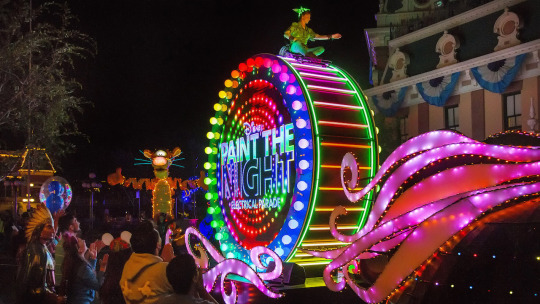
Disneyland is one of the highest-priced options in the area, second only to Universal Studios, and has practiced premium pricing in comparison to nearby alternatives like Six Flags or Knott’s Berry Farm. Disneyland is in a unique situation with their pricing. Due to the popularity of the brand, there is much demand for the parks, which has led to Disneyland reaching capacity in recent years and being forced to turn people away. Customers have also been expressing dissatisfaction with the increasingly crowded park’s wait times and overall experience. Disneyland obviously wants to maximize profits, but they also rely on loyal, continuously satisfied customers to frequent their parks. Therefore, Disneyland must be careful when raising or lowering prices; higher prices may result in less ticket sales but may also reduce crowding, leading to happier customers who may be more inclined to purchase merchandise within the park and become repeat customers, which may make this the best approach. Lowering prices to match competitors in the area would likely not be a good strategy for Disneyland because while they may reach a price point that allows the park to reach capacity every day, maximizing ticket sales, over time customers may become less loyal to this brand if the crowds make the service quality move outside their zone of tolerance, meaning it would not meet their perceived minimum level of service quality. This could lead to undesired customer behavior like negative word of mouth or switching to an alternative. With these concerns in mind, Disneyland introduced a demand-based dynamic pricing strategy in 2016 (Barnes, 2016). Prices for one day, one park tickets vary from $97.00 to $124.00 dollars these days. With this strategy, Disneyland hopes to increase demand for tickets on less popular days and control crowding on “peak” days, increasing customer satisfaction and their profits. Disneyland also offers prestige services like tours of the park, luxurious hotel rooms, and exclusive (and costly) dining options for customers looking for status and luxury during their vacation.
Agrawal, A. (2016, December 15). 17 Marketing Trends To Watch Out For In 2017. Retrieved November 26, 2017, from https://www.forbes.com/sites/ajagrawal/2016/12/15/17-marketing-trends-to-watch-out-for-2017/2/#
Barnes, B. (2016, February 27). Disney Introduces Demand-Based Pricing at Theme Parks. Retrieved November 26, 2017, from https://www.nytimes.com/2016/02/28/business/disney-introduces-demand-based-pricing-at-theme-parks.html
0 notes
Text
POST 10: “Services”
Most of Disneyland’s offerings are services, because they can only be experienced there. Disneyland is very serious about customer service, and Cast Members are expected to go above and beyond customer expectations to satisfy their needs and wants. Disneyland’s attractions and rides are also considered services because they are inseparable from the park. Due to their services being perishable, and unable to be stored for later use, Disneyland has introduced a new pricing strategy, offering tickets starting at $97.00 on “value” days and rising to a base price of $124.00 on “peak” days to stimulate demand for tickets on less popular days (Theme Park Tickets|Disneyland Resort). Disneyland also offers other intangible services, such as transportation from nearby hotels to the parks, entertainment like parades and shows, and hotel services like spa treatments and dining services. Disneyland’s service is one of the main reasons customers remain so loyal to this brand. Many brand loyal Disney fans will not consider alternatives like Knott’s Berry Farm or Six Flags Magic Mountain because they perceive the customer service to be superior at Disneyland. This adds much value to Disneyland compared to alternatives. Disneyland achieves this through empowerment of employees, allowing them to make decisions about services and create their famous “magic moments” for customers. At Disney University (the training program for new employees), they follow a set of values: “innovate, support, educate, and entertain…Disney has so endured because its leaders serve employees first and take great strides to constantly serve the customers better (BigSpeak Motivational Speakers Bureau, 2015)”.
BigSpeak Motivational Speakers Bureau. (2015, August 25). What Disneyland Can Teach Us About Customer Service. Retrieved November 24, 2017, from https://www.bigspeak.com/what-disneyland-can-teach-us-about-customer-service/
Theme Park Tickets|Disneyland Resort. (n.d.). Retrieved November 24, 2017, from https://disneyland.disney.go.com/tickets/
0 notes
Text
POST 9: “Brand Detail”
Disney’s brand name is obviously derived from the last name of Disney’s founder, Walt Disney. Disneyland’s main URL is https://disneyland.disney.go.com/. Their logos and symbols include the infamous mouse ears, which are seen in multiple places throughout the Disney parks, as well as Sleeping Beauty Castle, a central feature of Disneyland that has remained consistent in some way throughout the creation of new Disney parks and films.
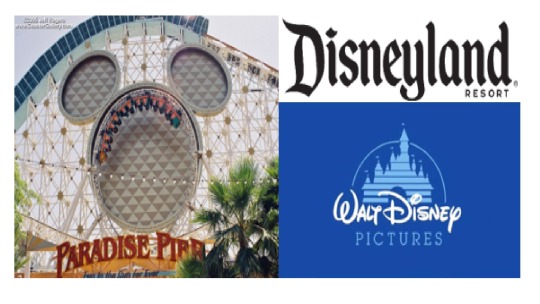
If there is one brand element that Disney has an abundance of, it is characters. Mickey Mouse remains the primary brand representative after he appeared in Steamboat Willie in 1928. Mickey has been joined by a large assortment of other Disney characters, many of which appear throughout the Disney parks. Disneyland’s brand associations, like characters, are a main selling point for their parks. Many attractions throughout “Fantasyland “and beyond pay homage to a plethora of popular Disney characters including Snow White, Peter Pan, Alice in Wonderland, and more, and favorite characters are often featured in parades in the parks. Another way Disneyland makes effective use of characters is through character dining and character greetings, where kids can meet Mickey, Minnie, Goofy, Donald, and their favorite princesses in person. This creates a once in a lifetime experience unique to Disneyland as well as lots of brand loyalty, as evidenced by their many season passholders who only use Disneyland when considering a vacation. Slogans like “The Happiest Place on Earth” also help attract customers to Disneyland for their family vacations. Disney was named the most powerful brand globally in 2016, taking the spot from Lego (Dill, 2016). This shows that Disney’s brand equity has a very high value, and much of this recent success can be attributed to Disney’s acquisition of many other brands, such as ESPN, Pixar, Marvel, and Lucasfilm. These acquisitions translate to the parks in the form of innovative new areas of the parks, rides, and merchandise. One example of this is the ESPN Zone in Downtown Disney. Pixar Pier will also replace Paradise Pier in 2018, offering new attractions and bringing in new characters to California Adventure (MacDonald, 2017). As far as the product mix goes, the Disneyland Resort’s product lines are hotels, shopping, dining, and theme parks, meaning their breadth is four. Their depth includes two unique theme parks, targeting slightly different audiences, three different hotels with unique features, and over 80 different dining options.
Dill, K. (2016, February 18). Disney Tops Global Ranking Of The Most Powerful Brands In 2016. Retrieved November 24, 2017, from https://www.forbes.com/sites/kathryndill/2016/02/18/disney-tops-global-ranking-of-the-most-powerful-brands-in-2016/#7d8553f93ecd
MacDonald, B. (2017, October 28). What to expect from Pixar Pier at Disney California Adventure. Retrieved November 24, 2017, from http://beta.latimes.com/travel/themeparks/la-tr-pixar-pier-disney-california-adventure-20171028-story.html
0 notes
Text
POST 7: “Packaging”
Disneyland is a specialty service because consumers will generally expend more search efforts when considering a vacation. Therefore, their actual product packaging is mostly made up of envelopes to hold tickets or annual passes and serves mainly a functional purpose, as the real product is the experience of going there. Disney uses a family brand technique, so Disneyland and the Disney Store also both sell Disney merchandise with Disney branded boxes and bags. One thing Disneyland could do to improve would be to use sustainable packaging such as recycled envelopes and reusable bags (which they do offer).
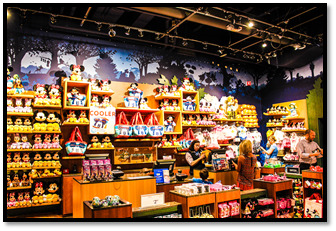
Disneyland has taken advantage of packaging inside the parks through popcorn buckets. Popcorn has been a staple Disneyland snack since opening day (Bshero, 2015), and they now offer exclusive collectible popcorn buckets for new movie debuts, holidays, and other park events. One of the newest buckets features a Nightmare Before Christmas character, and people have been waiting almost an hour to buy one before they sell out (Ulrich, 2017). Disneyland is creating perceived value with each of these limited time products and people are drawn to the park to get them before they are discontinued. This is a great way to use packaging to your advantage.
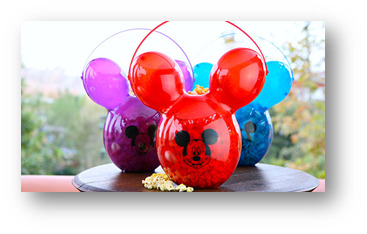
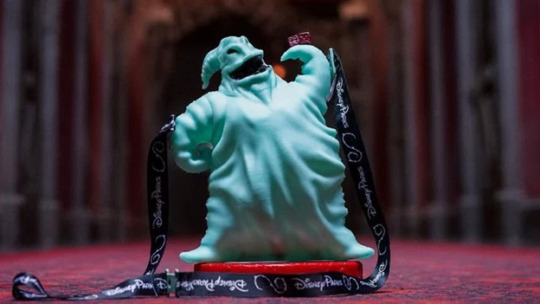
Bshero, R. (2015, January 29). Disneyland Resort Diamond Celebration - 60 Years of Popcorn. Retrieved October 14, 2017, from https://disneyparks.disney.go.com/blog/2015/01/disneyland-resort-diamond-celebration-60-years-of-popcorn/
Ulrich, K. (2017, September 21). Disneyland has released an Oogie Boogie popcorn bucket and we can’t wait to get our hands on one. Retrieved October 14, 2017, from http://www.altpress.com/news/entry/disneyland_oogie_boogie_popcorn_bucket
0 notes
Text
POST 6: “Competition”
Disneyland is in the amusement park industry. It operates in southern California and is affected by the regional culture of this area. The main generational cohort that Disney targets is digital natives. Therefore, Disneyland’s competitors are those firms that offer similar goods and services in the same area and target the same market. Disneyland’s key competitors include Universal Studios Hollywood, Knott’s Berry Farm, Sea World San Diego, and Six Flags Magic Mountain. Disneyland is the innovation leader in the amusement park industry and has the largest, most loyal following of the parks in the area due to its well-established brand name and superior customer service. In some ways, Disneyland is isolated from its competitors, but there are still some things Disneyland should watch out for from competitors.
Disneyland had 17,943,000 visitors in 2016, compared to 8,086,000 for Universal Studios Hollywood, 4,014,000 for Knott’s Berry Farm, 3,528,000 for Sea World San Diego, and 3,332,000 for Six Flags Magic Mountain (Rubin, 2017). These numbers indicate that Disneyland holds a comfortable lead in market share over the competition at around 25% for Parks and Resorts in the area (csimarket.com). Disneyland is definitely not the price leader in its industry, but isn’t the most expensive option either. With ticket prices starting at $97, Disneyland is significantly more expensive than Knott’s Berry Farm (tickets starting at $45), Sea World San Diego (tickets starting at $69.99), and Six Flags Magic Mountain (tickets start at $55.99). However, Universal Studios Hollywood was actually more expensive than Disneyland on the day I did my research, with tickets starting at $99. Universal Studios was also offering Southern California residents special pricing as well as monthly payment options, making it the most like Disneyland as far as pricing and deals goes.
Some of Disneyland’s competition has suffered from decreased attendance due to social trends like animal rights beliefs. The evaluative criteria of the modern consumer have changed, and treatment of animals has become a determinant attribute for many consumers. Sea World has been under fire in recent years for ethics concerns regarding treatment of animals, leading to negative word of mouth and a decreased attendance rate for them while the other parks’ attendance went up, highlighting the importance of ethics while doing business.
Universal Studios seems to be Disneyland’s main competitor in the theme park industry, despite bringing in less than half of the visitors Disneyland does. The park reached capacity for the first time ever in 2017 with estimations of over 40,000 people attending the park in one day. Universal Studios has also announced a partnership with Nintendo to add attractions based on Super Mario Bros. and Donkey Kong (Martin, 2017). Disneyland should note that Universal Studios is definitely attempting to sway consumers from Disneyland to its own park, expanding their park with new attractions and changes as well as using their established image within the movie industry to draw crowds in to real-life sets of their favorite movies, like Fast & Furious and King Kong, as well as their most recent addition, a Harry Potter themed area of the park. Universal Studios also offers Universal CityWalk, a three-block shopping center similar to Disneyland’s Downtown Disney. Disneyland must be wary of cheaper alternatives and the growing popularity of competition.
DIS's Competition by Segment and its Market Share. (n.d.). Retrieved October 14, 2017, from https://csimarket.com/stocks/competitionSEG2.php?code=DIS
Martin, H. (2017, January 03). Universal Studios Hollywood breaks attendance record and reaches capacity for the first time. Retrieved October 14, 2017, from http://www.latimes.com/business/la-fi-universal-studios-attendance-20170103-story.html
Rubin, J. (Ed.). (2017). Theme Index and Museum Index 2016. The Global Attractions Attendance Report, 31. doi: TEA/AECOM http://www.aecom.com/content/wp-content/uploads/2017/06/2016-ThemeMuseum-Index.pdf
0 notes
Text
POST 5: “Target Market”
Disneyland’s primary target market is middle to upper class families with young kids. Disneyland also focuses on consumers in the Southern California area through geographic segmentation, offering a monthly payment option for annual passes as well as discounts for these local consumers. Disney’s focus is obviously kids. Disneyland employs this form of demographic segmentation to target young consumers, specifically those interested in Disney movies, characters, and experiences. Kids offer a unique market segment, indirectly influencing $600 billion per year in family spending for items such as recreation and vacation. Disneyland works to market to families with a specific lifestyle, one that involves periodic family vacations.
Walt Disney was once quoted as saying “You’re dead if you aim only for kids. Adults are only kids grown up, anyway” (Lee, 2009). Disneyland keeps this in mind and attempts to offer universal appeal, diversifying its offerings with a differentiated targeting strategy and pursuing a secondary focus on young adults and especially young couples. In addition to rides and entertainment for youngsters, guests age 21 and over can order from a selection of cocktails and “secret menu” drinks from California Adventure’s Cove Bar or make reservations for a romantic dinner at Steakhouse 55. Disneyland also uses occasion segmentation, offering multiple wedding packages with several venues, sizes, and themes to choose from (disneyweddings.com), and holiday-themed events like Halloween Time during October.
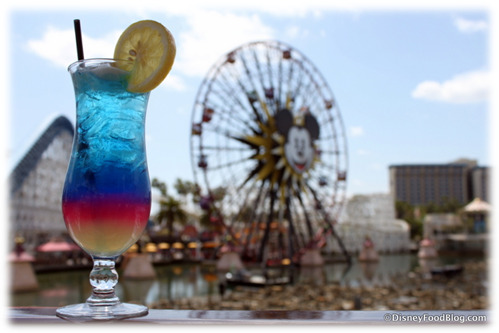
Disney's Fairy Tale Weddings & Honeymoons. (n.d.). Retrieved October 14, 2017, from https://www.disneyweddings.com/
Lee, M. (2009, October 16). A golden age of animation comes to life. Retrieved October 14, 2017, from http://www.telegraph.co.uk/culture/film/6343455/A-golden-age-of-animation-comes-to-life.html
0 notes
Text
POST 4: “SWOT”
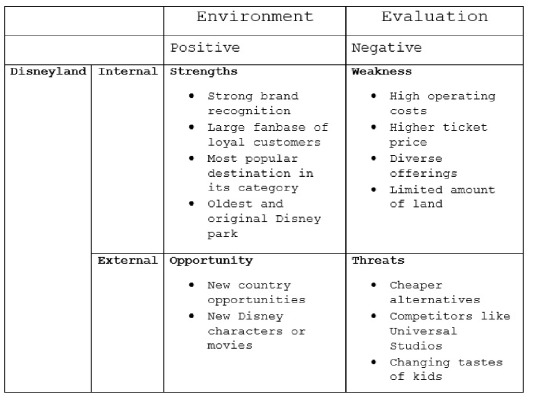
Strengths
Disneyland’s strengths lie in its already very strong brand recognition and large fanbase. Disney is already so well known it is probably in most people’s retrieval sets when they think of amusement parks, which is a huge strength. Disneyland in Anaheim is also the original Disney park, and the only park which was built with Walt Disney’s oversight. You can walk where Walt Disney did and see the bench he was sitting on when he had the idea for Disneyland. This is a strength unique to the park and could be a determinant attribute influencing a consumer’s decision to choose Disneyland.
Weaknesses
With Disney growing and changing their parks as well as expanding into other countries and buying companies like LucasArts, Pixar, and Maker Studios, their operating costs are extremely high. Disneyland also must consider many different factors when deciding how to change the park or which marketing opportunities to pursue due to their diverse offerings such as entertainment, lodgings, food, and shopping. Disneyland’s ticket prices are also higher than some other parks in the area. Disneyland is also surrounded by buildings unlike some other Disney parks, making expansion difficult.
Opportunity
Disney is already taking advantage of emerging markets in new countries by opening a new park in Shanghai. However, since there are so few Disney park locations compared to, say, Starbucks locations, there are many other countries Disney could consider a park for, including India, where Disney’s animated movies and merchandise have seen success recently (Team, 2017). Disneyland can also always look for opportunities to incorporate another product line of Disney’s, the latest movies and characters, into the parks to keep consumers interested.
Threats
Some of Disneyland’s competitors offer a lower ticket price. Knott’s Berry Farm, for example, sells tickets to its park for as low as $45, over $50 cheaper than Disneyland’s cheapest one-day ticket. Disneyland is also threatened by the growth of competitors like Universal Studios, who opened their own 1.6-billion-dollar upgrade in the form of the Wizarding World of Harry Potter in 2016 and could pull traffic away from Disneyland (Martin, 2016). Disneyland also must worry about macroenvironmental factors like the volatility of their target market, kids. Kids tastes can trend more towards video games these days and Disneyland must consider these social trends when choosing a marketing strategy.
After conducting this SWOT analysis, I believe the best opportunity to pursue is basically what Disneyland is already doing, which is incorporating the latest Disney characters and movies into the park. Opening a new park in another country is another opportunity they could pursue, but it is very costly and time consuming. Therefore, I think Disneyland’s idea of incorporating their latest acquisition, Star Wars, into the park is a good one. I think Disneyland could pursue this idea further if not for land constraints, but I hope to see them continue to expand on it in the future. Personally, I think it would be cool to see a ride or “land” that is villain themed someday. I believe that changing and modifying the park will always be a good opportunity for Disneyland to pursue.
Martin, H. (2016, April 07). Harry Potter could make Universal Studios a real rival to Disneyland. Retrieved October 12, 2017, from http://www.latimes.com/business/la-fi-universal-harry-potter-20160407-story.html
Team, T. (2017, January 04). Disney Is Restructuring Its Business In India. Retrieved October 12, 2017, from https://www.forbes.com/sites/greatspeculations/2017/01/04/disney-is-restructuring-its-business-in-india/#145aab8a7466
0 notes
Text
POST 3: “Strategy”
A key differentiator Disneyland has from other amusement parks in the area is that it has been around longer than parks like Magic Mountain and Legoland, and with the Disney silver screen characters behind it, the park has firmly established itself as the most visited park in the area and the second most-visited in the world, with Disney World in Florida being the first in 2015 (Dillinger, 2015). In addition to this, Disneyland has a sustainable competitive advantage in the form of customer service excellence and a high market share. Guests are to be treated with the utmost respect at Disneyland, and Cast Members are known to provide “magic moments” for families and go above and beyond to satisfy them. Disneyland trains their employees to be “assertively friendly”, meaning they should approach guests with help before they are asked and call customers by name when they are wearing a badge (Gallo, 2011). Many Disneyland customers are so loyal to this brand due to their incredible customer service. Disneyland incorporates this advantage into their marketing strategy, with ads promising a personalized experience for kids where “dreams come true”. In addition to customer service excellence, Disneyland also has product excellence, as tickets to their park have a high perceived value. High enough that despite Disneyland raising their prices every year, the park still reaches capacity sometimes. Disneyland provides an altogether unique experience that you can’t get anywhere else, has a strong brand, and a clear position in the marketplace. Disneyland’s main growth strategy lately seems to be diversification. One diversification strategy they use is constantly changing the parks to appeal to modern consumers, such as opening Star Wars land and revamping Tower of Terror with a Guardians of the Galaxy themed reskin. These are related diversification techniques because they appeal to Disneyland’s current target market, kids, but the changes could also attract Star Wars fans who are otherwise unlikely to visit the park or kids who were afraid of the previous theme of the Guardians of the Galaxy ride.
Dillinger, J. (2015, October 16). Most Popular Theme Parks By Attendance. Retrieved October 12, 2017, from http://www.worldatlas.com/articles/most-popular-theme-parks-in-the-world.html
Gallo, C. (2011, May 06). Customer Service the Disney Way. Retrieved October 12, 2017, from https://www.forbes.com/sites/carminegallo/2011/04/14/customer-service-the-disney-way/#2fc4552778f8
0 notes
Text
POST 2: “Brand”
Key Terms: metric, service, mission statement, corporate social responsibility, country culture
Disneyland opened its doors on July 17, 1955 with less than 20 attractions and a ticket price of $1.00. However, as Walt Disney said, “Disneyland will never be completed. It will continue to grow as long as there is imagination left in the world.” And grow it has. Disneyland now boasts over 50 attractions including rides, shows, and parades, plus a ticket price of $97.00-$124.00, depending on when you go. Disneyland has become iconic, and “the Happiest Place on Earth” garnered more than 18 million visitors in 2015 (Pimentel, 2017). Park attendance is a good metric for a business like Disneyland to use to measure their performance relative to competitors.
Disneyland is owned by its parent company, The Walt Disney Company (also known as Disney). Disney has been producing cartoons and films since the 1920s, and has always been an innovator in the industry. In 1937, Snow White and the Seven Dwarfs premiered, and was the first full-length traditionally animated feature film, and the highest grossing sound film at the time. In 1959, Disneyland was expanded and America’s first monorail system was implemented at the park. In 2006, Disney announced that it was buying Pixar, a successful computer animation studio. Disney also bought Marvel Entertainment, Lucasfilm, and Maker Studios, a YouTube based company (a great social media marketing opportunity), in order to market to a younger audience more effectively.
As far as what this means for the park, lots of changes and expansions are happening at Disneyland and the Disneyland Resort in general, with the construction of a “Star Wars” land currently underway at the park. That’s why one important thing to know about Disneyland is that much of their marketing is tied in with the larger Disney Company. This means that the park often capitalizes on the success of the films Disney releases. For example, Disneyland introduced a Cars-land in their California Adventure park after the successful release of the Cars movie. The characters and merchandise that appear in the park also coordinate with the films Disney has released recently.
Disneyland is classified as a service, meaning customers purchase a ticket in exchange for the experience they gain at the park, not a tangible item. Disneyland is also an example of a company that combines goods and services, in the form of exclusive Disney merchandise being sold at the park. The Disneyland Resort employs over 20,000 employees (whom they refer to as Cast Members), and is the number one employer in Orange County (Tully, 2012). The Walt Disney company as a whole has 195,000 full time employees and made $55 billion in revenue last year ("DIS Income Statement | Walt Disney Company Stock", 2017). The company’s theme parks provided close to a third of Disney’s total revenue in 2013 (Sylt, 2014).
The Disneyland Resort is located at 1313 Disneyland Dr., Anaheim, California, while the parent company, Disney, is located at 500 South Buena Vista Street, Burbank, California. Disney is a publicly traded company since 1957. Disney’s mission statement is as follows: "The mission of The Walt Disney Company is to be one of the world's leading producers and providers of entertainment and information. Using our portfolio of brands to differentiate our content, services and consumer products, we seek to develop the most creative, innovative and profitable entertainment experiences and related products in the world.” The mission statement makes it very clear that the Walt Disney Company strives for innovation, something evident at ever-changing Disneyland.
Disneyland also makes use of corporate social responsibility through donations and work with the Make-A-Wish program and more. My brother actually got to go to Disneyland for through the Make-A-Wish program, and it was a once in a lifetime experience for sure. In addition to this, Disneyland Cast Members volunteered more than 83,000 hours at 235 local events through their VoluntEARS program, which focuses on children and families, education, health, the environment, and more. Each year, Disney donates more than $350,000 to dozens of organizations through this program.
Disney is very good at advertising. The way Disney advertises is a great way to bridge the gap in country culture. Every country has kids, and Disney markets the exact same way in every country, changing only the language of the copy. This shows that a good way to bridge cultural gaps is to market to the same specific segment of the market in each country. Disney also shows its marketing prowess in how adaptive it is to the market. Disneyland is always changing aspects of the park based on what the consumer wants and needs. For example, a scene depicting a bride being auctioned off in the Pirates of the Caribbean ride is being redesigned to be more socially conscious of today’s views. Disneyland is a huge, dynamic company that I am very excited to explore further in later posts.
DIS Income Statement | Walt Disney Company Stock. (2017, September 16). Retrieved September 16, 2017, from https://finance.yahoo.com/quote/DIS/financials?p=DIS
Pimentel, J. (2017, May 18). Disneyland attracted 18.2 million visitors in 2015. Retrieved September 16, 2017, from http://www.ocregister.com/2016/05/26/disneyland-attracted-182-million-visitors-in-2015/
Sylt, C. (2014, November 21). The Secrets Behind Disney's $2.2 Billion Theme Park Profits. Retrieved September 16, 2017, from https://www.forbes.com/sites/csylt/2014/07/14/the-secrets-behind-disneys-2-2-billion-theme-park-profits/#459c711d584f
Tully, S. (2012, May 21). With California Adventure growth, Disney now No. 1 O.C. employer. Retrieved September 16, 2017, from http://www.ocregister.com/2012/05/21/with-california-adventure-growth-disney-now-no-1-oc-employer/
0 notes
Text
POST 1: “Brand Name”
Key terms: marketing mix, value, customer relationship management (CRM), relational orientation, customer excellence
I chose this brand because I am very interested in Disneyland both as a consumer and especially from a marketing perspective. Disneyland has such a large influence worldwide with parks in Paris, Tokyo, Hong Kong, and most recently Shanghai in addition to the original Anaheim park. Disneyland’s implementation of the marketing mix (or four Ps) is an interesting place to start.
Product (creating value): Disneyland has created value for their service over the past 60 years in part through innovation and impeccable customer service. They are quick to embrace new technologies and changes in the market. Due to their relatively few locations, Disneyland can focus a lot on creating a customer service oriented work environment.
Price (capturing value): I especially think Disneyland’s delicate balancing act of prices is pretty interesting. The perceived value of Disneyland’s offered experiences is worth a great deal to many consumers, leading them to be willing to pay higher prices in exchange for a ticket. However, Disneyland also has many loyal annual passholders here in Southern California who enjoy a monthly payment option for their passes. In recent years, Disneyland has reached capacity and had to turn people away. In response, Disney has steadily raised ticket and annual passholder prices to keep the limit from being reached and people reacting negatively. Some have urged Disneyland to remove the monthly payment option as a way to deal with the crowds, but Disneyland has to consider the sales of food, merchandise, tickets for fiends, parking costs, and other potential profit these local customers could bring in. Disneyland must consider all these factors and more when they set their ticket prices so they can maximize their daily earnings while satisfying the majority of customers with a price they feel is fair.
Place (delivering the value proposition): Disneyland is a pretty exclusive place due to the sheer amount of money, time, and space needed to build more parks. Unlike Starbucks, there is (unfortunately) not a Disneyland on every corner. However, Disneyland has definitely branched out geographically since the 1955 opening of the original park in Anaheim. In addition to a second Anaheim park (California Adventure), there are now Disneylands in multiple other countries. The most recent addition was Disneyland Shanghai, which opened in 2016 and had an original budget of $3.7 billion (Rapoza, 2015). Because Disneyland doesn’t have very many locations, the perceived value of the parks is high and people travel form around the world to visit the Happiest Place on Earth.
Promotion (communicating the value proposition): Disneyland is amazing at promotion. Ever since the original location opened, Disneyland has strived to remain viewed as the first choice for a family vacation. Disneyland is also embracing new technology such as their Disneyland app, where you can buy tickets, see wait times, look at maps, and more ("Disneyland® on the App Store", 2017).
Disneyland is good at customer relationship management. Disneyland’s new MagicBand initiative provides Disneyland extremely valuable data about a customer’s location and purchasing habits while in the park. Disneyland can then use this information to specialize marketing to each customer. Disneyland focuses on a relational orientation in order to build long term relationships with customers. For example, their annual passes grant you discounts on food and merchandise, encouraging you to come back when a new product is released at the park or a new restaurant opens. Disneyland is known for its “magic moments” with customers and aims to treat each customer as a special individual. Disneyland has definitely achieved customer excellence, as evidenced by its large number of extremely loyal customers.
Overall, I am very excited to understand why Disneyland does some of the things it does and how it affects the market. I’m also interested in the numbers behind things, which I will discuss in post 2. Disneyland has been a favorite place of mine my whole life, and I feel it is a very important company because it is so influential in so many places and such a recognizable brand. It will be fascinating to study how they became the giant they are today and see the numbers behind the park.
Disney. (2017, August 23). Disneyland® on the App Store. Retrieved September 16, 2017, from https://itunes.apple.com/us/app/disneyland/id1022164656?mt=8
Rapoza, K. (2013, March 08). Shanghai Disney To Open 2015. Retrieved September 16, 2017, from https://www.forbes.com/sites/kenrapoza/2013/03/08/shanghai-disney-to-open-2015/#14fde1834869
0 notes